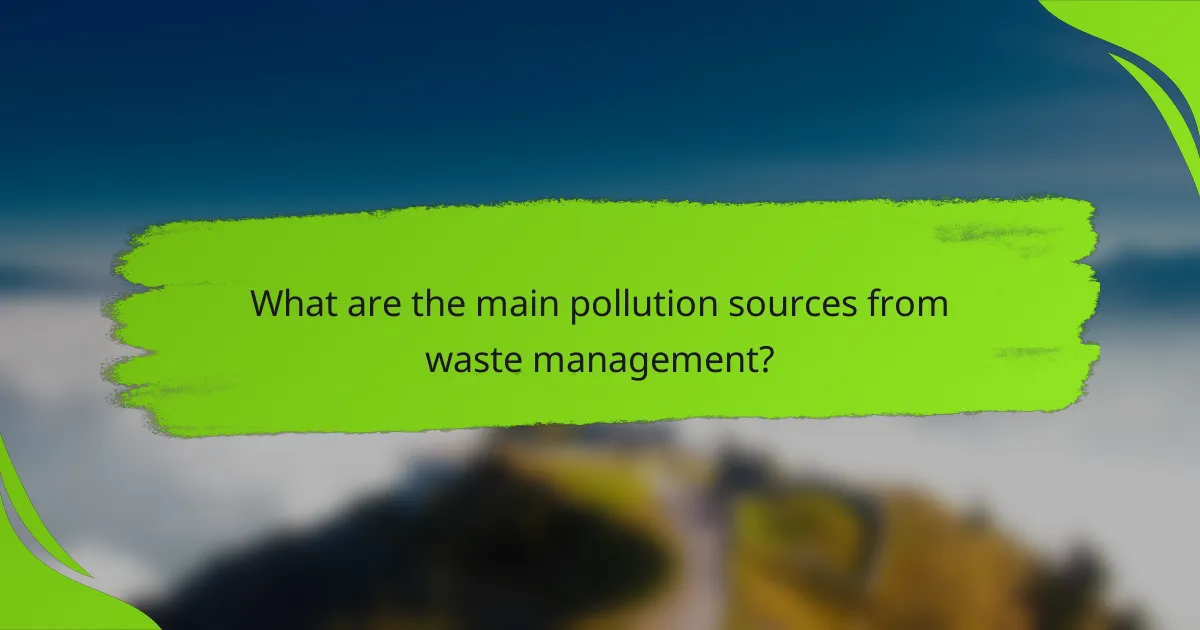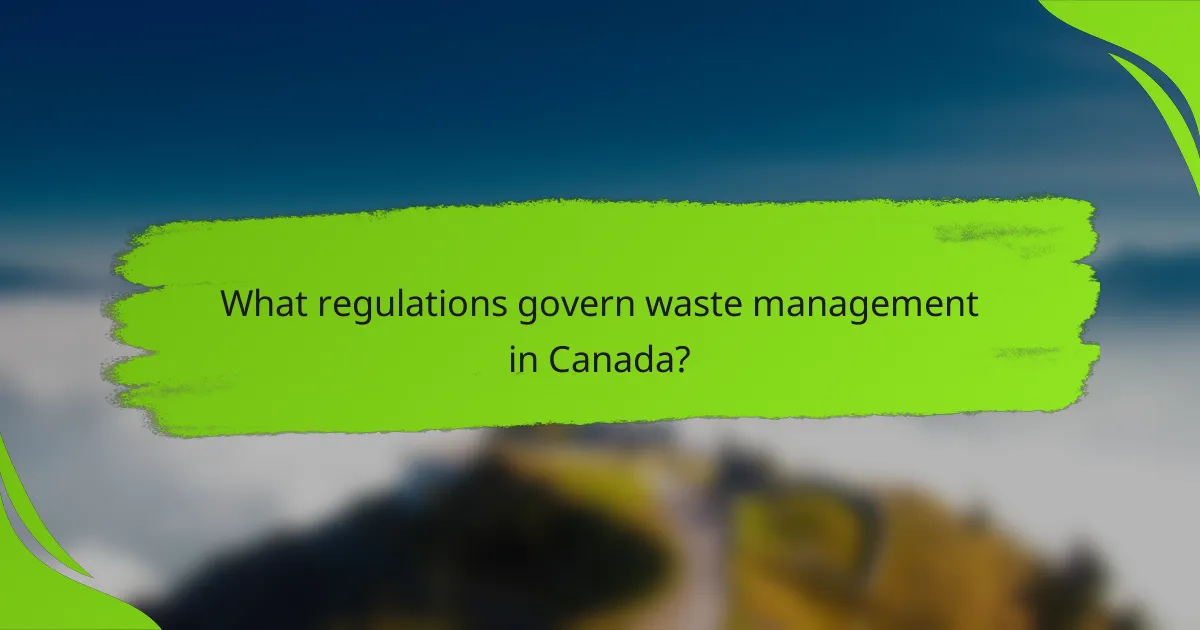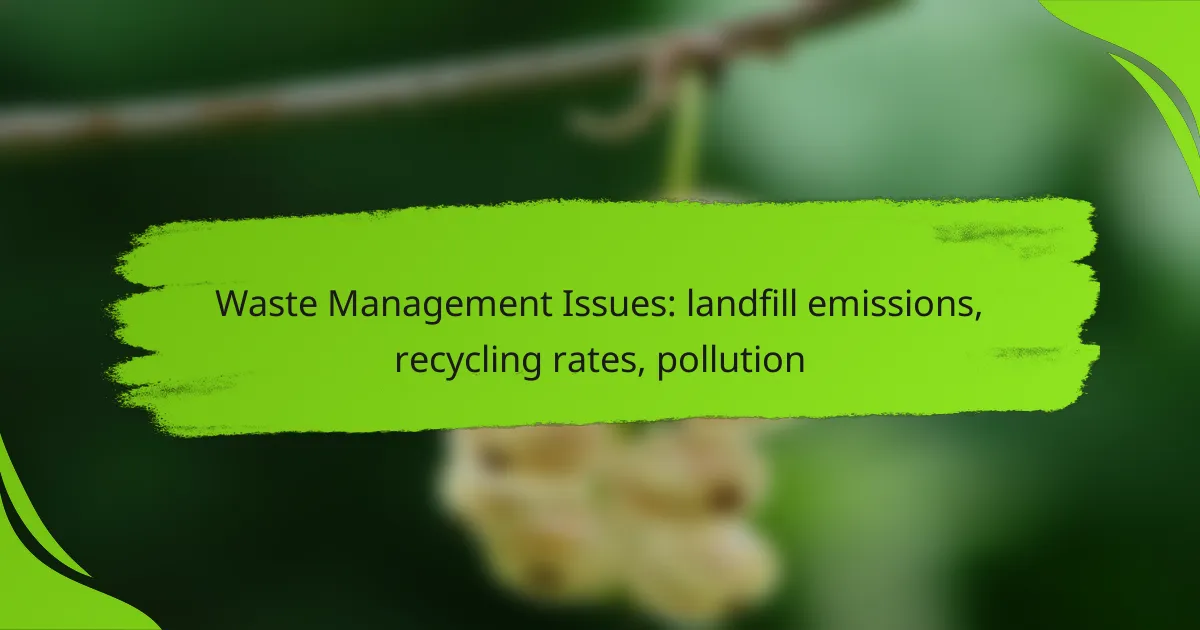Waste management issues, particularly landfill emissions, recycling rates, and pollution, pose significant challenges to environmental sustainability. Effective solutions are needed to address greenhouse gas emissions from landfills, improve community engagement in recycling efforts, and mitigate pollution from various waste sources. By implementing innovative technologies and enhancing public awareness, we can work towards a cleaner and more sustainable future.

What are the solutions to landfill emissions in Canada?
Solutions to landfill emissions in Canada focus on reducing greenhouse gases and improving waste management practices. Key strategies include implementing gas capture technology, converting waste to energy, and enhancing landfill management practices.
Gas capture technology
Gas capture technology involves the collection of methane and other gases produced by decomposing waste in landfills. This technology typically uses a network of wells and pipes to extract gases, which can then be flared or used for energy production. By capturing these emissions, landfills can significantly reduce their impact on climate change.
In Canada, many landfills are adopting this technology to comply with environmental regulations and to take advantage of potential revenue from energy generation. The effectiveness of gas capture systems can vary, often capturing around 60-90% of emitted gases, depending on the landfill’s design and management.
Waste-to-energy conversion
Waste-to-energy conversion transforms non-recyclable waste materials into usable energy, typically in the form of electricity or heat. This process reduces the volume of waste sent to landfills while generating energy that can be used locally. In Canada, several facilities are operating or being planned to harness this technology.
While waste-to-energy conversion can significantly reduce landfill emissions, it is essential to ensure that the process does not produce harmful pollutants. Technologies such as advanced combustion and gasification are being developed to minimize emissions and improve efficiency.
Improved landfill management practices
Improved landfill management practices focus on optimizing operations to minimize emissions and enhance environmental protection. This includes regular monitoring of gas emissions, proper waste segregation, and implementing best practices for leachate management. Effective management can lead to lower emissions and better compliance with environmental standards.
Landfills can adopt practices such as daily cover, which helps reduce odors and emissions, and the use of liners to prevent leachate from contaminating groundwater. Training staff on sustainable practices is also crucial for maintaining compliance and improving overall landfill performance.

How can recycling rates be improved in Canadian cities?
Improving recycling rates in Canadian cities can be achieved through targeted strategies that engage the community, provide incentives, and enhance the recycling systems in place. By focusing on public awareness, incentive programs, and better infrastructure, cities can significantly boost recycling participation and effectiveness.
Public awareness campaigns
Public awareness campaigns play a crucial role in educating residents about the importance of recycling and how to do it correctly. Effective campaigns can utilize various media channels, including social media, local newspapers, and community events, to reach a broad audience.
For instance, cities can organize workshops or informational sessions that provide practical tips on recycling, such as what materials are accepted and how to prepare items for collection. Engaging local influencers or community leaders can further amplify these messages.
Incentive programs for recycling
Incentive programs can motivate residents to recycle more by offering tangible rewards for participation. These programs might include deposit return schemes for beverage containers or discounts on utility bills for households that demonstrate high recycling rates.
Additionally, municipalities can implement point systems where residents earn points for recycling, which can be redeemed for local services or products. Such initiatives not only encourage recycling but also foster a sense of community involvement.
Enhanced recycling infrastructure
Enhancing recycling infrastructure is essential for making recycling more accessible and efficient. This can involve increasing the number of recycling bins in public spaces, ensuring they are clearly marked and easy to use.
Moreover, cities should invest in advanced sorting facilities that can handle a wider variety of materials, reducing contamination rates and improving the quality of recycled products. Regular maintenance and updates to these facilities are also necessary to keep pace with evolving recycling technologies and regulations.

What are the main pollution sources from waste management?
The primary pollution sources from waste management include landfill leachate, airborne emissions from incineration, and microplastics resulting from improper waste disposal. Each of these sources poses significant environmental challenges that require targeted strategies for mitigation.
Landfill leachate
Landfill leachate is a liquid that forms when rainwater seeps through waste materials, dissolving various contaminants. This leachate can contain heavy metals, organic compounds, and pathogens, posing risks to groundwater and surface water quality.
To manage leachate, landfills must implement effective containment systems, such as liners and leachate collection systems. Regular monitoring and treatment of leachate are essential to prevent environmental contamination and comply with regulations.
Airborne emissions from incineration
Airborne emissions from incineration occur when waste is burned, releasing pollutants such as dioxins, furans, and particulate matter into the atmosphere. These emissions can contribute to air quality issues and pose health risks to nearby communities.
To minimize airborne emissions, incineration facilities should utilize advanced technologies like flue gas cleaning systems. Regular emissions testing and adherence to environmental standards are crucial for reducing the impact of incineration on air quality.
Microplastics from waste disposal
Microplastics are tiny plastic particles that result from the breakdown of larger plastic waste. They can enter the environment through landfills, wastewater treatment plants, and litter, leading to widespread pollution in oceans and waterways.
To combat microplastic pollution, it is important to improve waste management practices, increase recycling rates, and promote the use of biodegradable materials. Public awareness campaigns can also encourage proper disposal and recycling of plastics to reduce their environmental footprint.

What regulations govern waste management in Canada?
In Canada, waste management is primarily regulated through federal and provincial laws aimed at minimizing environmental impact and promoting sustainable practices. Key regulations include the Canadian Environmental Protection Act and various provincial waste management regulations that set standards for waste disposal, recycling, and emissions control.
Canadian Environmental Protection Act
The Canadian Environmental Protection Act (CEPA) is a cornerstone of federal environmental legislation that addresses pollution prevention and waste management. It provides a framework for managing hazardous waste and controlling emissions from landfills and other waste facilities.
Under CEPA, the government can set regulations that limit the release of pollutants into the environment, ensuring that waste management practices do not harm public health or the ecosystem. This includes monitoring landfill emissions and promoting recycling initiatives to reduce waste generation.
Provincial waste management regulations
Each province in Canada has its own waste management regulations that complement CEPA, focusing on local needs and conditions. These regulations often dictate how waste is collected, sorted, and disposed of, as well as the requirements for recycling programs.
For example, provinces like British Columbia and Ontario have implemented extended producer responsibility (EPR) programs, which require manufacturers to manage the lifecycle of their products, including end-of-life disposal. This approach encourages recycling and reduces landfill use.

What are the challenges of recycling in remote Canadian communities?
Remote Canadian communities face significant challenges in recycling due to geographical isolation and limited resources. These issues hinder effective waste management and contribute to environmental pollution.
Lack of transportation access
Transportation access is a major barrier for remote communities when it comes to recycling. Many of these areas lack reliable road networks, making it difficult to transport recyclable materials to processing facilities. As a result, valuable resources often end up in landfills instead of being recycled.
In some cases, communities may rely on seasonal transportation options, such as ice roads, which can limit the frequency and volume of material that can be moved. This sporadic access can lead to accumulation of recyclables, creating additional waste management challenges.
Limited local processing facilities
Limited local processing facilities further complicate recycling efforts in remote Canadian communities. Many regions do not have the infrastructure needed to sort and process recyclable materials, forcing residents to ship their waste long distances. This not only increases costs but also contributes to greenhouse gas emissions from transportation.
Without nearby facilities, communities may struggle to meet recycling targets set by provincial regulations. Establishing local processing options could significantly enhance recycling rates and reduce overall waste, but funding and logistical support are often lacking.

How do landfill emissions impact climate change?
Landfill emissions significantly contribute to climate change primarily through the release of greenhouse gases, particularly methane. As organic waste decomposes anaerobically in landfills, it generates methane, which is far more effective at trapping heat in the atmosphere than carbon dioxide.
Methane as a greenhouse gas
Methane is a potent greenhouse gas, with a global warming potential many times greater than that of carbon dioxide over a short time frame. It can remain in the atmosphere for about a decade before breaking down, making its immediate impact on climate change substantial.
In landfills, methane is produced when organic materials like food scraps and yard waste decompose without sufficient oxygen. This process can lead to emissions that account for a significant portion of a landfill’s overall greenhouse gas output, often estimated in the low tens of percent.
To mitigate methane emissions, effective waste management strategies such as improving recycling rates and composting organic waste are essential. Implementing these practices can reduce the volume of waste sent to landfills, thereby decreasing methane production and its associated climate impacts.
